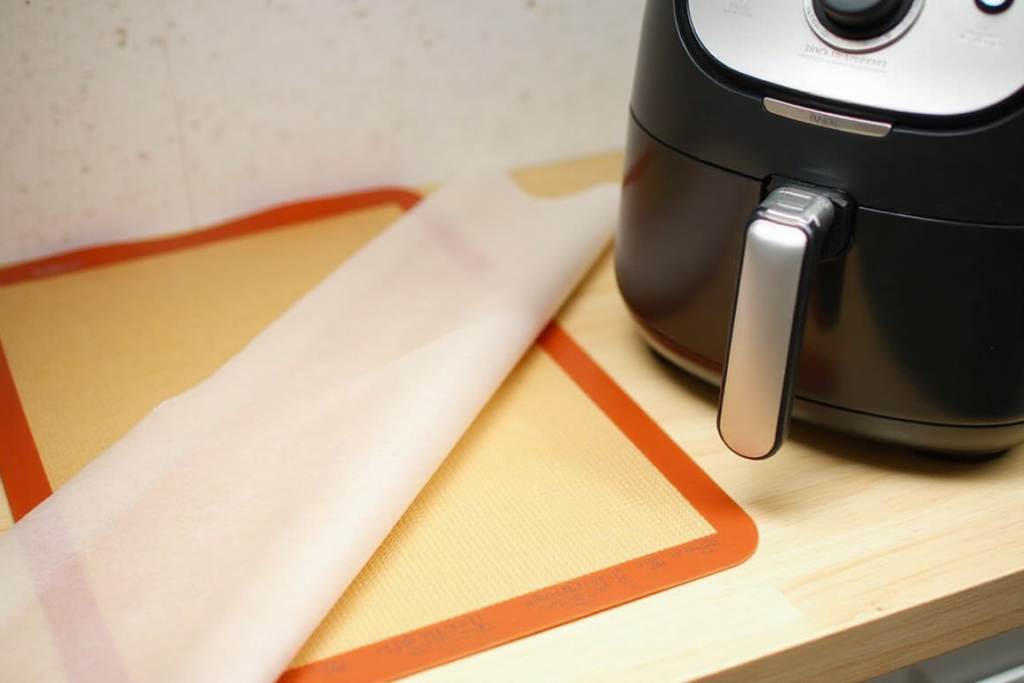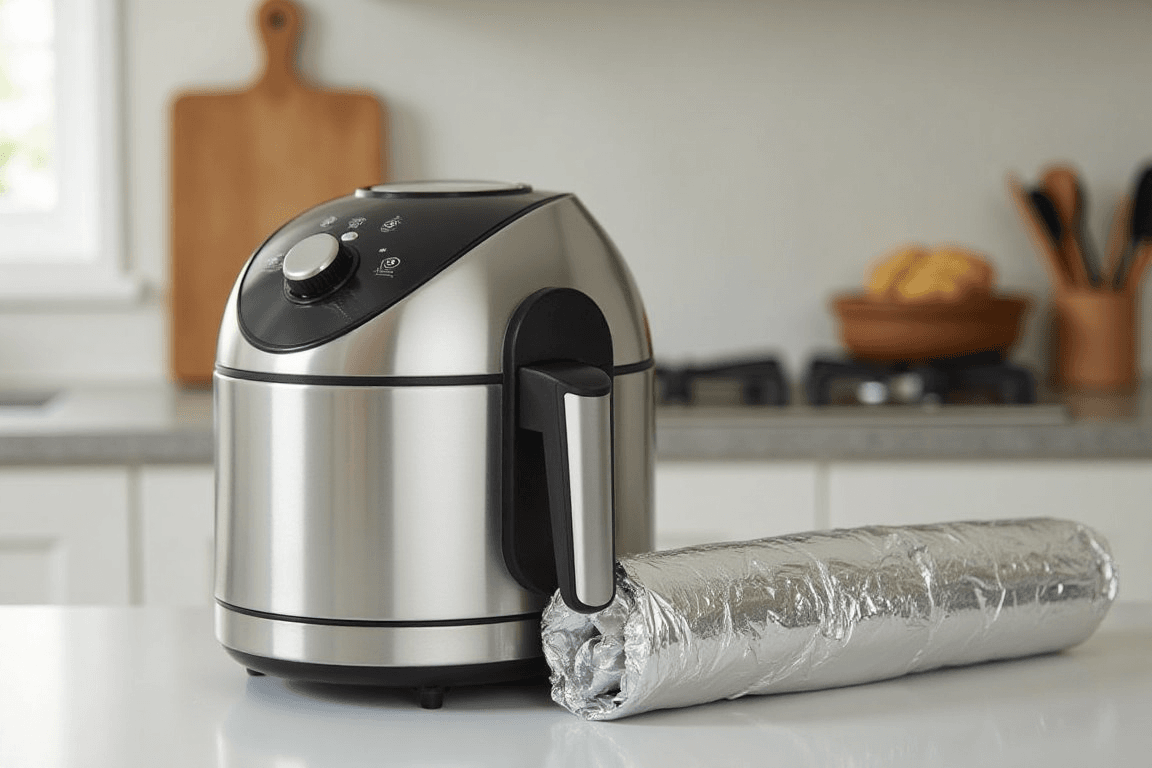Introduction
Air fryers have revolutionized home cooking with their ability to fry, bake, and roast with minimal oil. As air fryers become more common, so do questions about how to use them safely and efficiently. One of the most frequently asked questions is whether it is safe to use aluminum foil in an air fryer. While it can be a convenient solution for cleanup or cooking certain foods, there are important considerations to keep in mind to ensure safety and effectiveness.
This article explores the pros and cons of using aluminum foil in an air fryer, the best practices for doing so, and safer alternatives for specific cooking needs. By understanding these guidelines, you can get the most out of your air fryer while protecting your appliance and ensuring delicious results every time.

Understanding How Air Fryers Work
Air fryers have become a staple kitchen appliance due to their convenience and ability to produce crispy, flavorful dishes without excessive oil. To better understand how aluminum foil interacts with an air fryer, it’s essential to first grasp the appliance’s mechanism.
The Mechanism of an Air Fryer
At its core, an air fryer uses rapid air circulation to cook food. The appliance contains a heating element at the top, often combined with a powerful fan. This setup creates a convection effect, where hot air is circulated quickly and evenly around the food, producing a crispy texture similar to frying.
The key to effective cooking in an air fryer is uninterrupted airflow. The basket design often includes perforations, allowing hot air to move freely and cook the food from all sides. Blocking these perforations, even partially, can interfere with the process, leading to uneven cooking.
Key Features of Air Fryers
- Adjustable Temperature Settings: Air fryers typically operate between 180°F and 400°F (82°C to 204°C), making them versatile for a variety of dishes.
- Cooking Time Efficiency: Air fryers cook faster than conventional ovens, relying on the quick circulation of hot air.
- Oil-Free or Minimal-Oil Cooking: Unlike deep fryers, air fryers require little to no oil, making them a healthier alternative.
These features demonstrate why airflow is critical to their function—and why improper use of materials like aluminum foil may compromise performance.
Is Aluminum Foil Safe to Use in an Air Fryer?
Using aluminum foil in an air fryer can be both beneficial and problematic, depending on how it is applied. Here’s a detailed look at the safety considerations:
Pros of Using Aluminum Foil in an Air Fryer
- Enhanced Heat Conduction: Aluminum foil is an excellent heat conductor. It can help evenly distribute heat around certain foods, especially those that may stick to the basket or require precise cooking.
- Ease of Cleaning: Placing foil at the bottom of the air fryer basket can catch drippings, sauces, or crumbs, reducing the need for scrubbing.
- Food Separation: Wrapping food items like fish, chicken, or vegetables in foil can help keep flavors distinct and prevent ingredients from mixing.
Cons of Using Aluminum Foil in an Air Fryer
- Airflow Blockage: Improperly placed foil can block the perforations in the basket, restricting airflow. This leads to uneven cooking and defeats the purpose of using an air fryer.
- Potential Safety Hazards: If the foil comes into contact with the heating element, it could cause sparks or even fires. This is particularly a risk when using oversized or loosely placed foil.
- Impact on Food Quality: Wrapping food too tightly can trap moisture, preventing the food from achieving a crispy texture.
- Chemical Reaction with Certain Foods: Acidic foods like tomatoes or citrus can react with aluminum, potentially affecting taste and safety.
Best Practices for Using Aluminum Foil in an Air Fryer
While aluminum foil can be used safely in an air fryer, following best practices ensures optimal performance and safety. These guidelines help you avoid common pitfalls while reaping the benefits of using foil in your appliance.
Placement Tips
- Avoid Blocking Airflow:
- Place foil only in the basket, ensuring it doesn’t cover the holes or slots that allow hot air to circulate.
- Avoid laying foil over the entire basket surface; instead, use it sparingly for areas that need protection or support.
- Secure the Foil:
- Tightly wrap or press the foil against the food or basket edges to prevent it from being blown around by the fan. Loose foil can come into contact with the heating element and create safety risks.
- Keep a Safe Distance from the Heating Element:
- Maintain at least a 1-inch gap between the foil and the air fryer’s heating element to avoid overheating or sparking.
Types of Foods That Benefit from Foil
Certain foods are ideal for foil use in an air fryer due to their textures or preparation requirements:
- Marinated or Saucy Foods: Wrapping foods like barbecue chicken or salmon in foil prevents sauce drips and keeps the basket clean.
- Sticky Foods: Items like glazed vegetables or cheese-covered nachos can be cooked on a layer of foil to prevent sticking.
- Delicate Foods: Foods that break apart easily, such as flaky fish or tender pastries, can be supported with foil to maintain their shape.
Foods to Avoid Using with Aluminum Foil
- Highly Acidic Foods:
Foods like tomatoes, lemon slices, or dishes with vinegar-based marinades can react with aluminum foil, creating a metallic taste and potentially releasing harmful chemicals. - Foods Requiring Maximum Crispiness:
Items like French fries or fried chicken may lose their signature crispy texture if wrapped too tightly in foil. These foods are best cooked directly on the basket for even airflow. - Overly Wet Foods:
Foods with excessive moisture can steam rather than fry when wrapped in foil, reducing the effectiveness of the air fryer.
Alternatives to Aluminum Foil in an Air Fryer

While aluminum foil can be helpful, it’s not the only option for managing cleanup, maintaining food quality, or enhancing safety in an air fryer. Here are several alternatives to consider, each with its own benefits.
Parchment Paper
Parchment paper is a popular alternative to aluminum foil, offering versatility and safety for various cooking tasks.
- Non-Stick Surface:
Parchment paper is naturally non-stick, making it ideal for foods that tend to adhere to the basket, such as baked goods or sticky marinades. - Airflow-Friendly Designs:
Pre-perforated parchment paper liners are specifically designed for air fryers, allowing hot air to circulate freely while protecting the basket from messes. - Heat Resistance:
Most parchment paper can withstand temperatures up to 450°F (232°C), making it suitable for nearly all air fryer recipes. - Limitations:
Parchment paper may not be as sturdy as foil and is less effective for shaping or wrapping foods. It is also more prone to tearing under heavy loads.
Silicone Mats
Silicone mats are a durable and eco-friendly alternative to aluminum foil.
- Reusable and Cost-Effective:
Unlike foil or parchment paper, silicone mats can be washed and reused multiple times, reducing waste and saving money over time. - Non-Toxic and Safe:
Made from food-grade silicone, these mats are heat-resistant and free from harmful chemicals, ensuring safety even at high temperatures. - Versatility:
Silicone mats are available in various shapes and sizes to fit different air fryer baskets. They’re ideal for cooking delicate items and preventing sticking. - Limitations:
- Some silicone mats may trap moisture, leading to less crispy results for certain foods.
- Over time, mats can develop stains or odors if not cleaned thoroughly.
Air Fryer-Specific Accessories
Many manufacturers offer accessories designed specifically for air fryers, which can serve as effective alternatives to aluminum foil:
- Metal Grids and Racks:
These allow you to elevate foods for better airflow and can catch drips without blocking ventilation. - Mesh Liners:
These liners are reusable and facilitate airflow while protecting the basket from food residue. - Disposable Liners:
Made from heat-resistant materials, disposable liners combine convenience and safety without obstructing airflow.
Why Choose Alternatives?
Alternatives like parchment paper and silicone mats not only address some of the limitations of aluminum foil but also reduce environmental impact. They ensure optimal cooking results without compromising the performance of your air fryer.
Frequently Asked Questions
To address common concerns about using aluminum foil in an air fryer, here are detailed answers to frequently asked questions:
Can Aluminum Foil Catch Fire in an Air Fryer?
No, aluminum foil is not flammable under the conditions present in an air fryer. However, improper use—such as placing loose or oversized foil near the heating element—can cause sparking. This risk increases with air fryers that have exposed heating elements. Always ensure the foil is secured and kept away from direct contact with the element.
Will Aluminum Foil Damage the Air Fryer Basket?
If used correctly, aluminum foil will not damage the air fryer basket. Problems arise when the foil scratches non-stick coatings or blocks airflow, leading to uneven cooking and potential wear on the basket. Use foil sparingly and avoid sharp folds that could scrape the basket.
How Much Aluminum Foil is Safe to Use?
The amount of aluminum foil you use should be minimal and tailored to the specific recipe. Covering the entire basket or overusing foil can disrupt airflow and compromise cooking performance. Instead, line only the necessary areas or wrap individual food items.
Are There Health Concerns with Using Aluminum Foil?
While aluminum foil is generally safe for cooking, long-term exposure to aluminum, particularly when heated with acidic foods, has raised minor health concerns in some studies. To minimize risks, avoid using foil with highly acidic dishes and choose alternatives like parchment paper for such recipes.
Can You Use Foil with Acidic Foods?
No, it’s best to avoid using aluminum foil with foods like tomatoes, lemons, or vinegar-based marinades. Acidic foods can react chemically with aluminum, imparting a metallic taste to the dish and potentially leaching small amounts of aluminum into the food.
Are There Better Alternatives to Aluminum Foil?
Yes, alternatives like parchment paper, silicone mats, and air fryer-specific liners offer safer and more versatile solutions. These materials are designed to handle high temperatures without the risks associated with foil, such as blocked airflow or chemical reactions.
Conclusion
Aluminum foil can be a helpful tool for cooking in an air fryer, offering benefits like easier cleanup, enhanced heat distribution, and food separation. However, its use requires careful consideration to avoid safety risks, ensure even cooking, and protect the appliance. Blocking airflow or placing foil too close to the heating element can lead to uneven results or potential damage.
By following best practices—such as securing the foil, keeping it away from heating elements, and using it sparingly—you can safely enjoy its benefits. Additionally, understanding which foods are compatible with aluminum foil and exploring alternatives like parchment paper or silicone mats can further enhance your air frying experience.
As air fryers continue to grow in popularity, taking the time to learn about their proper use, including materials like aluminum foil, ensures safe, efficient, and delicious results every time you cook.

